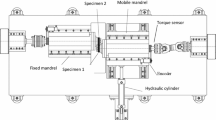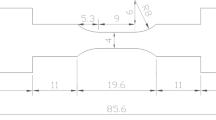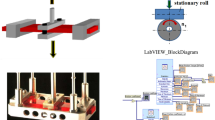Abstract
This article investigates the influence of a counterpart on fretting wear of cold-rolled high strength steel for automotive applications. Fretting wear tests are conducted using a ball-on-flat test apparatus. The friction forces between cold-rolled high strength steel plates and various counterparts are measured. The worn profile of a cold-rolled high strength steel specimen is determined to calculate the wear rate. Experimental results show that the ratio of the maximum tangential to the normal force at a contact surface varies with a counterpart material. Measured worn surface profiles indicate that the cross-sectional area of a wear scar is enlarged as the number of cycles increases. The effects of counterpart hardness and the maximum Hertzian contact pressure are identified on the wear rate of cold-rolled high strength steel. From measurement and analysis results, ZrO2 counterparts are found to be more adequate than the commercial ones for the cold-rolled high strength steel rails.
Similar content being viewed by others
Abbreviations
- a :
-
Hertz contact radius
- A :
-
the cross-sectional area
- a c :
-
measured contact radius
- d p :
-
the average wear depth
- E :
-
elastic modulus
- P:
-
normal force
- P o :
-
the maximum contact pressure
- Q:
-
tangential force
- Qmax :
-
the maximum tangential force
- R :
-
radius of a ball
- V w :
-
total wear volume
- \({\dot v_w}\) :
-
wear rate
- δ :
-
displacement
- δ ac :
-
actual sliding amplitude
- δ t :
-
total displacement amplitude
- ν:
-
Poisson’s ratio
References
Hofmann, H., Mattissen, D., and Schaumann, T. W., “Advanced Cold Rolled Steels for Automotive Applications,” Steel Research International, vol. 80, no. 1, pp. 22–28, 2009.
Kuziak, R., Kawalla, R., and Waengler, S., “Advanced High Strength Steels for Automotive Industry,” Archives of Civil and Mechanical Engineering, vol. 8, no. 2, pp. 103–117, 2008.
Kim, K., “A Study of the Frictional Characteristics of Metal and Ceramic Counterfaces Against Electro-Deposited Coatings for Use on Automotive Seat Rails,” Wear, vol. 320, pp. 62–67, 2014.
Kim, K., “Measurement and Analysis of Friction and Wear on Electrodeposited Coatings Against a High Carbon Chrome Steel Ball,” Journal of Materials Research, vol. 31, no. 13, pp. 1865–1872, 2016.
Fettis, G., “Automotive Paints and Coatings,” Wiley, 1995.
Totten, G. E., “ASM Handbook, Volume 18: Friction, Lubrication, and Wear Technology,” ASM International, 1992.
Vingsbo, O. and Söderberg, S., “On Fretting Maps,” Wear, vol. 126, no. 2, pp. 131–147, 1988.
Bhushan, B., “Introduction to Tribology,” John Wiley & Sons, 2013.
Kim, K. and Yoon, M. J., “Characterisation of Friction Behaviour of Flake, Spheroidal, and Compacted Vermicular Graphite Cast Irons,” International Journal of Surface Science and Engineering, vol. 9, no. 1, pp. 1–12, 2015.
Kim, K. and Eom, K., “Measurement and Analysis of the Kinetic Friction Coefficient of AISI 52100 and Ceramic Balls on Cold-Rolled High Strength Steel,” International Journal of Surface Science and Engineering, vol. 10, no. 4, pp. 353–364, 2016.
Ruiz-Andres, M., Conde, A., De Damborenea, J., and Garcia, I., “Influence of Sliding Direction Changes, Contact Frequency and Bauschinger Effect on the Wear of Dual Phase Steels,” Tribology International, vol. 92, pp. 485–492, 2015.
Landolt, D. and Mischler, S., “Tribocorrosion of Passive Metals and Coatings,” Elsevier, 2011.
Choi, Y. and Lee, J., “A Study on the Effects of Surface Dimple Geometry on Fretting Fatigue Performance,” International Journal of Precision Engineering and Manufacturing, vol. 16, no. 4, pp. 707–713, 2015.
Bae, J. W., Lee, C. Y., and Chai, Y. S., “Three Dimensional Fretting Wear Analysis by Finite Element Substructure Method,” International Journal of Precision Engineering and Manufacturing, vol. 10, no. 4, pp. 63–69, 2009.
Sackfield, A., Hills, D., and Nowell, D., “Mechanics of Elastic Contacts,” Elsevier, 2013.
Varenberg, M., Etsion, I., and Halperin, G., “Slip Index: A New Unified Approach to Fretting,” Tribology Letters, vol. 17, no. 3, pp. 569–573, 2004.
Author information
Authors and Affiliations
Corresponding author
Rights and permissions
About this article
Cite this article
Kim, K., Baek, S.Y. Studies on the Influence of a Counterpart on Fretting Wear of Cold-Rolled High Strength Steel. Int. J. Precis. Eng. Manuf. 19, 713–719 (2018). https://doi.org/10.1007/s12541-018-0085-0
Received:
Revised:
Accepted:
Published:
Issue Date:
DOI: https://doi.org/10.1007/s12541-018-0085-0




